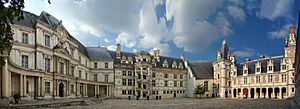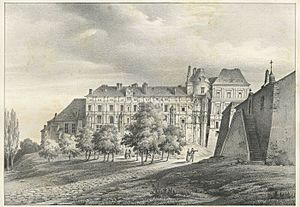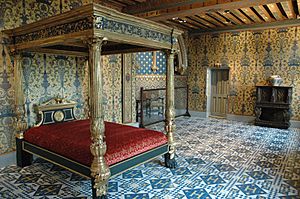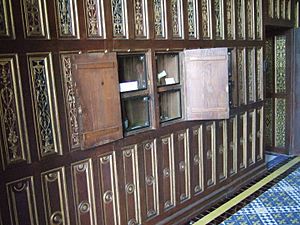Château of Blois facts for kids
The Royal Château of Blois is a famous castle located in the city of Blois, France. It sits in the beautiful Loire Valley. This castle was once home to the Counts of Blois and several French kings. Even Joan of Arc visited in 1429 to receive a blessing before leading her army against the English.
The château was very important, controlling the area of Blois until 1397. Later, it became a key place for the Duchy of Orléans and the Kingdom of France between 1498 and 1544. The castle is made up of several buildings, built from the 13th to the 17th century. It shows four different styles of architecture: parts of the old 13th-century medieval fortress, the Gothic-style wing from King Louis XII's time, the Renaissance-style wing from King Francis I, and the Classical-style wing from Gaston of Orléans. In total, the château has 564 rooms, including 100 bedrooms, each with a fireplace!
Today, the Musée des Beaux-Arts de Blois (Museum of Fine Arts of Blois) is located in the Louis XII wing. It displays paintings, sculptures, and decorative arts from the 16th to the 19th century. The museum opened in 1850.
History of the Château
Early Days: Counts of Blois
The Blois castle, first called Blisum castrum, was attacked by Viking leader Hastein in 854. In the 10th and 11th centuries, the Counts of Blois rebuilt the fortress. Count Theobald I built a large tower. By the end of the 12th century, the Counts finished their work by building the St-Sauveur Collegiate Church.
The "Estates General Room" (Salle des États Généraux) was built in the early 13th century. It is one of the oldest and largest Gothic rooms in France. This room was used as a court by the Counts of Blois. It was also used in 1576 and 1588 for meetings of the Estates General, which were assemblies of different groups of people in France.
Becoming a Royal Home
In 1397, the medieval castle was given to Louis I, Duke of Orléans, who was the brother of King Charles VI. After Louis was killed, his wife, Valentina Visconti, moved to Blois Castle. Their son, Charles d'Orléans, later inherited it. Charles was a poet who was captured and held prisoner in England for 25 years after the Battle of Agincourt.
When Charles returned, he helped rebuild the château to make it more comfortable. It became a favorite royal home and the political center of the kingdom. This happened when Charles's son, Count Louis II, became King Louis XII of France in 1498.
King Louis XII's Changes
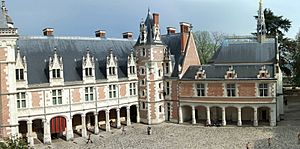
At the start of the 16th century, King Louis XII began rebuilding the main entrance. He also created a beautiful Italian garden with terraced flowerbeds.
This new wing is made of red brick and grey stone. It forms the main entrance to the château. Above the entrance, there is a statue of the king on horseback. The style is mostly Gothic, with pointed arches and tall decorations. However, it also has some Renaissance elements, like a small chandelier.
King Francis I's Grand Designs
When Francis I became king in 1515, his wife Queen Claude wanted to move from the Château d'Amboise to Blois. Francis started building a new wing and created one of the most important libraries of that time in the castle. After his wife died in 1524, he spent less time at Blois. His huge library was moved to the royal Palace of Fontainebleau. This library later became the foundation of the Bibliothèque nationale de France, France's national library.
Since King Louis XII was involved in the Italian Wars, which brought the Renaissance style to France, this wing shows a lot of Italian influence. In the middle of the wing is a grand spiral staircase. It is covered with beautiful sculptures and looks out onto the château's central courtyard. These impressive stairs were a model for those built a few years later at the Château de Chambord. Behind this wing is the "Lodges Façade," which has a series of open spaces.
Kings Henry III and Henry IV
During the French Wars of Religion, King Henry III had to leave Paris and came to Blois. He held meetings of the Estates General here in 1576 and 1588. In December 1588, the King's enemy, Henry I, Duke of Guise, was killed at the château. The next day, the Duke's brother, Louis II, Cardinal of Guise, was also killed inside the castle.
After these events, King Henry IV, the first king from the House of Bourbon, occupied the castle. When Henry died in 1610, his wife, Marie de' Medici, was sent to Blois as an exile by her son, King Louis XIII.
Duke Gaston of Orléans's Project
In 1626, King Louis XIII gave the area of Blois and the Château of Blois to his brother, Gaston, Duke of Orléans, as a wedding gift. In 1634, Gaston began building a completely new wing for the château. The famous architect François Mansart was in charge of this project. Mansart started with a main house at the back of the courtyard. This house was meant to be the first part of a huge rebuilding plan. However, the project stopped in 1638 when Gaston's nephew, who would become Louis XIV, was born. With Louis XIV's birth, Gaston was no longer the heir to the throne and could not get money for the project.
This wing forms the back wall of the courtyard, directly across from the Louis XII wing. The middle part has three levels, showing different styles of columns: Doric, Ionic, and Corinthian.
By the time of the French Revolution, the huge castle had been neglected for over 130 years. Many of its statues, royal symbols, and coats of arms were removed. The Château of Blois was in very bad condition and was almost torn down. Luckily, it was saved and used as a military barracks instead.
Saving the Château
In 1840, thanks to Prosper Mérimée, the château was put on the list of historical monuments. This meant that government money could be used to save it. It was restored by the architect Félix Duban.
Today, the town of Blois owns and maintains the château. It is open to the public as a museum and a tourist attraction. Visitors can see the "Chamber of Secrets," which was likely used to display valuable objects for guests.
People Linked to the Château
People Born in the Château
- Charles of Blois (in 1319)
- Louis XII (in 1462), who became King of France
- Marguerite Louise d'Orléans (in 1645), daughter of Gaston, Duke of Orléans
People Who Died in the Château
- Anne of Brittany (in 1514), who was married to Louis XII
- Claude of France (in 1524), daughter of King Louis XII and Queen Anne of Brittany, married to Francis I
- Henry I of Guise (in 1588)
- Louis II of Guise (in 1588), Duke of Guise's brother
- Catherine de' Medici (in 1589), wife of King Henry II, who was sent to Blois by her son, King Henry III
- Gaston, Duke of Orléans (in 1660), son of King Henry IV and the last Count of Blois
Images for kids
-
The rear of the Francis I wing, facing over central Blois in the 1890s
See also
 In Spanish: Castillo de Blois para niños
In Spanish: Castillo de Blois para niños
- Châteaux of the Loire Valley
- Gardens of the French Renaissance
- List of castles in France


